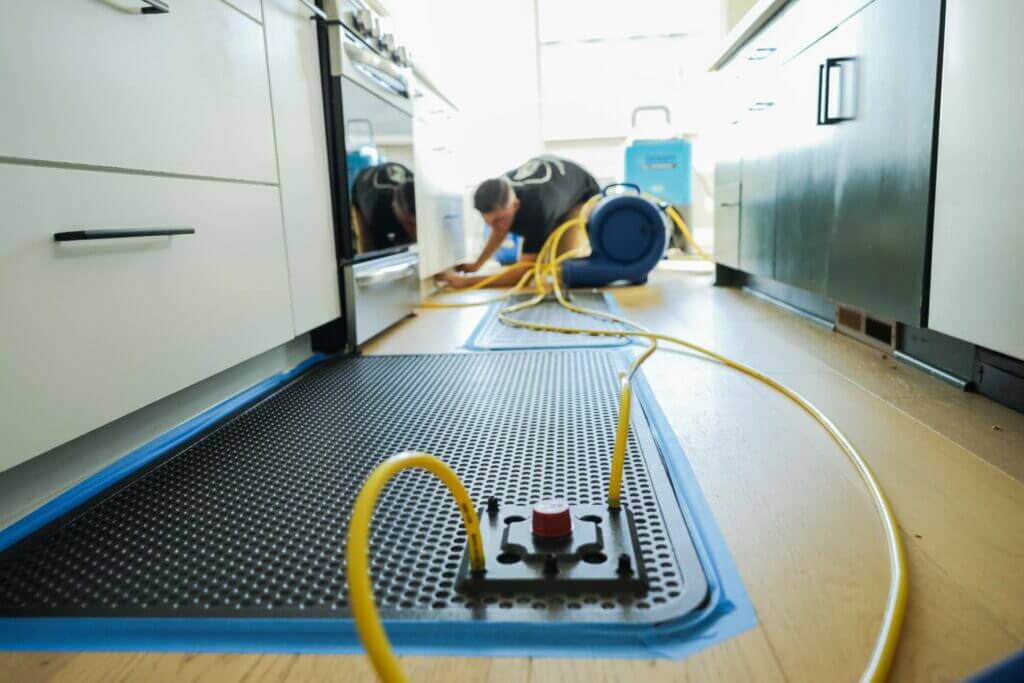“How Long Does Water Damage Restoration Take? A Comprehensive Guide”
Water damage can wreak havoc on homes and businesses alike, leading to structural issues, mold growth, and other costly damages. Understanding the time it takes for water damage restoration is crucial for mitigating further damage and restoring your property to its pre-loss condition. In this guide, we’ll delve into the intricacies of water damage restoration timelines, offering valuable insights and tips for expediting the process.


Water damage is a common yet challenging issue faced by property owners worldwide. Whether caused by burst pipes, flooding, or leaky roofs, water intrusion can lead to significant damage if not addressed promptly. In this article, we’ll explore the question, “How long does water damage restoration take?” and provide an in-depth overview of the restoration process.
Understanding Water Damage Restoration
Water damage restoration is the process of mitigating and repairing damage caused by water intrusion. It typically involves several stages, including assessment, water extraction, drying, dehumidification, cleaning, and restoration. The duration of the restoration process depends on various factors, such as the extent of the damage, the type of water involved, and the restoration techniques employed.
Importance of timely restoration
Timely restoration is paramount for limiting the scope of damage and thwarting subsequent problems like mold proliferation and structural degradation. Swift action not only reduces the risk of health complications stemming from water damage, such as exposure to harmful contaminants and allergens but also safeguards the integrity of the affected property. By promptly addressing water damage, individuals can significantly mitigate both immediate and long-term consequences, ensuring a safer and more resilient environment for inhabitants.
Assessment of Damage
A thorough assessment of the damage is essential before initiating the restoration process, as this will determine the appropriate course of action.
Initial inspection
During the initial inspection, professionals thoroughly evaluate the scope of water damage present, meticulously examining affected areas to determine the full extent of the issue. Identifying the precise source of water intrusion is crucial during this phase, as it enables the development of a tailored restoration strategy aimed at addressing both the visible damage and underlying causes, ensuring a comprehensive and practical approach to restoration efforts.
Determining the extent of damage
Assessing the affected areas, such as walls, floors, ceilings, and structural components, allows for a comprehensive understanding of the damage incurred. This enables accurate planning and allocation of resources for restoration efforts. This systematic evaluation aids in identifying not only visible damages but also underlying issues, ensuring thorough restoration to mitigate further risks or complications.
Identifying affected areas
Identifying all areas affected by water damage, including concealed spaces like those behind walls and beneath flooring, is imperative for thorough restoration efforts. By uncovering hidden damage, professionals can address underlying issues effectively, mitigating the risk of future problems such as mold growth or structural decay.
The Water Damage Restoration Process
Now, let’s delve into the various stages of the water damage restoration process:
Assessment and Inspection
After conducting a thorough assessment of the damage, the restoration team meticulously identifies all impacted regions, taking into account both visible and hidden damage. Subsequently, they devise a detailed and strategic restoration plan, outlining specific steps and timelines to efficiently restore the affected areas to their original condition.
Water Extraction
Powerful pumps and advanced extraction equipment efficiently eliminate excess water from the property, mitigating the risk of further damage and expediting the drying process. This strategic approach not only prevents structural deterioration but also ensures a swift restoration process, minimizing disruption and restoring normalcy to the affected area.
Drying and Dehumidification
Industrial-grade dehumidifiers and drying equipment play a crucial role in mitigating mold growth and preventing secondary damage by efficiently extracting moisture from both the air and structural materials. Their deployment ensures a rapid and thorough drying process, safeguarding the integrity of buildings and valuable assets against the detrimental effects of excess humidity.
Cleaning and Sanitization
After a meticulous cleaning process, surfaces and items are treated with sanitizing agents to eradicate mold, bacteria, and any lingering odors, ensuring a hygienic environment. This comprehensive approach not only eliminates potential health hazards but also restores freshness and cleanliness to the affected areas and belongings.
Restoration and Repairs
In the final stage of the restoration process, efforts are directed towards returning the property to its original state prior to the incident, encompassing tasks such as repairing any structural impairments, substituting damaged components, and applying fresh coats of paint as necessary. This comprehensive approach ensures that the property is fully restored both functionally and aesthetically, meeting the standards of its pre-loss condition.
Factors Affecting Restoration Timelines
Several factors influence the duration of water damage restoration:
Extent of Damage
The severity and extent of water damage play a significant role in determining the restoration timeline. Minor water damage may be resolved within a few days, while extensive damage requiring structural repairs and mold remediation can take several weeks.
Size of the affected area
When dealing with larger affected areas, the restoration process often necessitates more comprehensive efforts, which inherently extend the duration required for completion. Factors such as the scope of damage, availability of resources, and logistical challenges contribute to the longer timeframe associated with restoring larger areas.
Type of water damage (clean water, grey water, black water)
The type of water damage, whether it originates from clean water sources such as pipes or contaminated sources like sewage, significantly impacts the restoration process and time frame. Clean water damage typically involves more straightforward cleanup procedures and shorter restoration times compared to contaminated water damage, which requires thorough sanitization measures and may prolong the restoration process due to health and safety considerations.
Presence of mold or other contaminants
The presence of mold or other contaminants can significantly impede the restoration process by necessitating additional remediation steps, such as thorough cleaning, sanitization, or even structural repairs. Addressing these contaminants effectively is crucial to ensure a safe and healthy environment post-restoration, requiring careful assessment and targeted interventions to mitigate any potential health risks or structural damage.
Access to Property
The efficiency of restoring affected areas heavily relies on accessibility; obstacles or limited access can significantly impede progress, potentially prolonging the restoration timeline. Overcoming such challenges often requires innovative solutions and coordination among stakeholders to ensure swift and effective restoration efforts.
Availability of equipment and resources
The efficiency of the restoration process can be significantly influenced by the accessibility of essential equipment, such as drying apparatus, which aids in expediting the restoration of damaged items or structures. Moreover, the availability of an adequate workforce is crucial as it ensures tasks are carried out promptly, minimizing downtime and maximizing the overall effectiveness of the restoration efforts.
Typical Time Frame for Restoration
The time frame for restoration can vary depending on the severity of the damage and other factors.
Minor water damage
Minor water damage restoration typically involves the process of thoroughly drying out the affected areas using specialized equipment such as dehumidifiers and fans, followed by cleaning surfaces to prevent mold growth and restore structural integrity. This restoration process typically spans from a few days to a week, depending on the extent of the damage and the efficiency of the restoration efforts.
Moderate water damage
Moderate water damage typically necessitates a restoration timeline of one to two weeks due to the need for thorough drying, cleaning, and repair procedures. This extended period allows professionals to address the extent of the damage effectively and ensure the affected areas are restored adequately to their pre-damaged condition.
Severe water damage
Restoring severe water damage can be a lengthy process, often spanning from several weeks to months, particularly when structural repairs are necessary, and contaminants have infiltrated the affected area. The intricate nature of remediation efforts, which may involve drying out soaked materials, replacing compromised structures, and thoroughly decontaminating the space, contributes to the extended timeframe required for full restoration.
Importance of Swift Action
Taking prompt action after water damage is crucial in preventing further damage and minimizing health risks.
Preventing further damage
Taking swift action is crucial in preventing secondary issues like mold growth, structural damage, and deterioration of belongings. Timely intervention can mitigate the extent of damage and save valuable resources. By addressing issues promptly, individuals can safeguard their property and minimize the need for costly repairs or replacements in the future.
Minimizing health risks
Taking immediate action diminishes the likelihood of prolonged contact with harmful substances, thus preserving the overall health and welfare of individuals within the vicinity. Swift response also mitigates the potential spread of allergens, contributing to a safer and more comfortable environment for occupants.
Avoiding long-term structural issues
Timely restoration efforts are crucial for maintaining a building’s structural stability, as they effectively address water damage before it escalates into more severe issues. By promptly addressing such damages, property owners can mitigate the risk of structural decay and the emergence of costly repairs, ensuring the longevity and safety of the building.
How Long Does Water Damage Restoration Take?
The duration of water damage restoration varies depending on the factors above. In general, minor water damage can be addressed within a few days to a week, while more extensive damage may take several weeks to complete.
Tips to Expedite the Restoration Process
Here are some tips to expedite the water damage restoration process:
- Prompt Action: Act quickly to mitigate further damage by contacting a reputable restoration company as soon as water damage is discovered.
- Clear Communication: Maintain open communication with the restoration team and follow their recommendations to ensure a smooth and efficient restoration process.
- Proper Documentation: Keep detailed records of the damage, including photos and documentation of the restoration process, for insurance purposes.
- Professional Expertise: Trust experienced professionals to handle the restoration process, as DIY attempts may exacerbate the damage and prolong the timeline.
FAQs (Frequently Asked Questions)
How long does water damage restoration take on average?
The duration of water damage restoration varies depending on the extent of the damage, ranging from a few days to several weeks.
Can I stay in my home during the restoration process?
In most cases, it’s safe to remain in your home during water damage restoration, but you may need to relocate if extensive repairs are required temporarily.
Will my insurance cover water damage restoration costs?
Many homeowner’s insurance policies cover water damage restoration, but coverage may vary depending on the cause of the damage and your policy terms. It’s essential to review your insurance policy and contact your provider for clarification.
How can I prevent water damage in the future?
To prevent water damage, regularly inspect your property for leaks, maintain your plumbing system, ensure proper drainage around your home, and consider installing a sump pump or water leak detection system.
What are the health risks associated with water damage?
Water damage can lead to mold growth, which can exacerbate allergies, respiratory issues, and other health problems. Prompt restoration and mold remediation are essential for mitigating health risks.
Is it necessary to hire a professional restoration company?
While minor water damage may be manageable with DIY efforts, professional restoration companies have the expertise, equipment, and resources to ensure thorough and effective restoration, reducing the risk of further damage and mold growth.
Conclusion
In conclusion, the duration of water damage restoration can vary depending on several factors, including the extent of the damage, the type of water involved, and access to the property. By understanding the restoration process and taking prompt action, property owners can expedite the restoration process and minimize the impact of water damage on their homes or businesses.

